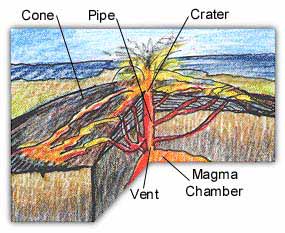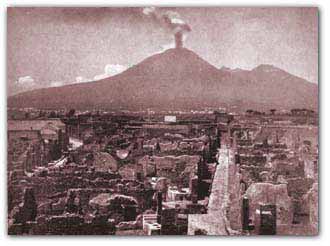 Volcanoes
Volcanoes 

Welcome to Kaiti's Volcano Page. I will start by telling you a little
about volcanoes. At the bottom of a volcano, there is a magma chamber.
When pressure builds up in the magma chamber, it flows out through the
top of the volcano. There are different types of eruptions. Most
of the eruptions take place on the ocean floor so we do not see them.
Another is a hydrovolcanic eruption.
 A
volcano consists of a vent , pipe, crater, and cone. A vent is an
opening in the Earth. A pipe is where the magma rises on the way
to the vent. A crater is a bowl-shaped depression at the top of the
volcano where ash, lava, and other materials are released. Lava,
ash, and cinder make up the cone by building up on the side of the volcano.
A
volcano consists of a vent , pipe, crater, and cone. A vent is an
opening in the Earth. A pipe is where the magma rises on the way
to the vent. A crater is a bowl-shaped depression at the top of the
volcano where ash, lava, and other materials are released. Lava,
ash, and cinder make up the cone by building up on the side of the volcano.
 In
some places, there are hot spots. Hot spots are places within the
mantle where rocks melt to generate magma. Some examples of these
are the Hawaiian hot spot and the Yellowstone hot spot. The Hawaiian
hot spot has been active for at least 70 million years. The Yellowstone
hot spot has been active for at least 15 million years. In the hot
spots, the lava can keep building up on the ground and cause flood basalts.
In
some places, there are hot spots. Hot spots are places within the
mantle where rocks melt to generate magma. Some examples of these
are the Hawaiian hot spot and the Yellowstone hot spot. The Hawaiian
hot spot has been active for at least 70 million years. The Yellowstone
hot spot has been active for at least 15 million years. In the hot
spots, the lava can keep building up on the ground and cause flood basalts.

One of the volcanoes in Africa is called Barrier. It is made up of
four different volcanic centers. This volcano runs between Lake Turkana
and Lake Longipi. The volcanoes create a dam between the 2 lakes.
There are tuff cones on the north and south sides of Barrier with lake
sediments on them, showing that the lakes were very high at one time.
Barrier has erupted 9 times. The last time was in 1921. It
is 12.5 miles long and 9 miles wide. Geothermal energy can be found
around these volcanoes. There are also many faults around the Barrier
complex.

Mt. Cleveland is another volcano. It is located in North America
near Chuginadak Island, which is in Alaska. Mt. Cleveland is a stratovolcano
and is almost symmetrical. It is 5 miles wide at its base.
Mt. Cleveland, along with another volcano, form the east side of Chuginadak
Island.
 Cleveland is one of the most active volcanoes in the Aleutians. It
has erupted 8 times since 1893. A soldier was killed by the volcano
while stationed there in June of 1944. There was a brief eruption
in May of 1994. This cause ash to be sent 10.5 km.
Cleveland is one of the most active volcanoes in the Aleutians. It
has erupted 8 times since 1893. A soldier was killed by the volcano
while stationed there in June of 1944. There was a brief eruption
in May of 1994. This cause ash to be sent 10.5 km. 
 You
may not think so, but lava flow is actually the least hazardous of all
the dangers. The distance the lava will flow depends on the temperature
of it. If the lava is cold, it will not go as far. If it is
warmer, it goes farther. Most don't move very fast so people rarely
get killed by them. It can cause injuries though because it is so
hot. It can be between 550 degrees Celsius and 1400 degrees Celsius.
For more information on the hazards, go to Hazards
Prevention.
You
may not think so, but lava flow is actually the least hazardous of all
the dangers. The distance the lava will flow depends on the temperature
of it. If the lava is cold, it will not go as far. If it is
warmer, it goes farther. Most don't move very fast so people rarely
get killed by them. It can cause injuries though because it is so
hot. It can be between 550 degrees Celsius and 1400 degrees Celsius.
For more information on the hazards, go to Hazards
Prevention.
 Inside
of the earth, rocks are melted. They turn into a substance called
magma. As the magma rises, some is collected in the magma chamber.
When it gets closer to the earth, the pressure goes down and the magma
gases expand. Then it goes through the openings in the earth as causes
an eruption. To learn more go to Causes
of Eruptions.
Inside
of the earth, rocks are melted. They turn into a substance called
magma. As the magma rises, some is collected in the magma chamber.
When it gets closer to the earth, the pressure goes down and the magma
gases expand. Then it goes through the openings in the earth as causes
an eruption. To learn more go to Causes
of Eruptions.
 How do you know when a volcano will erupt? Well, it's hard to predict
this but there are some signs. Magmatic eruptions are some of the
easier ones to detect. With these, as the magma flows to the surface,
it will cause ground deformations, heat flow, and the temperature will
change around the spring waters. There could be rising steam and
hot ground. For more links go to Predictions
How do you know when a volcano will erupt? Well, it's hard to predict
this but there are some signs. Magmatic eruptions are some of the
easier ones to detect. With these, as the magma flows to the surface,
it will cause ground deformations, heat flow, and the temperature will
change around the spring waters. There could be rising steam and
hot ground. For more links go to Predictions
or Volcanoes

 Volcanoes
Volcanoes  A
volcano consists of a vent , pipe, crater, and cone. A vent is an
opening in the Earth. A pipe is where the magma rises on the way
to the vent. A crater is a bowl-shaped depression at the top of the
volcano where ash, lava, and other materials are released. Lava,
ash, and cinder make up the cone by building up on the side of the volcano.
A
volcano consists of a vent , pipe, crater, and cone. A vent is an
opening in the Earth. A pipe is where the magma rises on the way
to the vent. A crater is a bowl-shaped depression at the top of the
volcano where ash, lava, and other materials are released. Lava,
ash, and cinder make up the cone by building up on the side of the volcano.
 In
some places, there are hot spots. Hot spots are places within the
mantle where rocks melt to generate magma. Some examples of these
are the Hawaiian hot spot and the Yellowstone hot spot. The Hawaiian
hot spot has been active for at least 70 million years. The Yellowstone
hot spot has been active for at least 15 million years. In the hot
spots, the lava can keep building up on the ground and cause flood basalts.
In
some places, there are hot spots. Hot spots are places within the
mantle where rocks melt to generate magma. Some examples of these
are the Hawaiian hot spot and the Yellowstone hot spot. The Hawaiian
hot spot has been active for at least 70 million years. The Yellowstone
hot spot has been active for at least 15 million years. In the hot
spots, the lava can keep building up on the ground and cause flood basalts.
 Cleveland is one of the most active volcanoes in the Aleutians. It
has erupted 8 times since 1893. A soldier was killed by the volcano
while stationed there in June of 1944. There was a brief eruption
in May of 1994. This cause ash to be sent 10.5 km.
Cleveland is one of the most active volcanoes in the Aleutians. It
has erupted 8 times since 1893. A soldier was killed by the volcano
while stationed there in June of 1944. There was a brief eruption
in May of 1994. This cause ash to be sent 10.5 km.  You
may not think so, but lava flow is actually the least hazardous of all
the dangers. The distance the lava will flow depends on the temperature
of it. If the lava is cold, it will not go as far. If it is
warmer, it goes farther. Most don't move very fast so people rarely
get killed by them. It can cause injuries though because it is so
hot. It can be between 550 degrees Celsius and 1400 degrees Celsius.
For more information on the hazards, go to
You
may not think so, but lava flow is actually the least hazardous of all
the dangers. The distance the lava will flow depends on the temperature
of it. If the lava is cold, it will not go as far. If it is
warmer, it goes farther. Most don't move very fast so people rarely
get killed by them. It can cause injuries though because it is so
hot. It can be between 550 degrees Celsius and 1400 degrees Celsius.
For more information on the hazards, go to 
 How do you know when a volcano will erupt? Well, it's hard to predict
this but there are some signs. Magmatic eruptions are some of the
easier ones to detect. With these, as the magma flows to the surface,
it will cause ground deformations, heat flow, and the temperature will
change around the spring waters. There could be rising steam and
hot ground. For more links go to
How do you know when a volcano will erupt? Well, it's hard to predict
this but there are some signs. Magmatic eruptions are some of the
easier ones to detect. With these, as the magma flows to the surface,
it will cause ground deformations, heat flow, and the temperature will
change around the spring waters. There could be rising steam and
hot ground. For more links go to